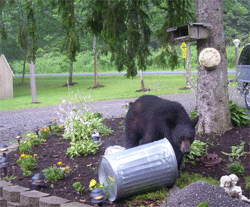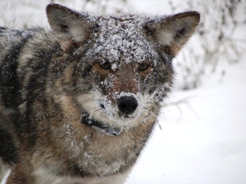DEC GUIDANCE / ALERTS
DEC ISSUES GUIDANCE TO REDUCE CONFLICTS WITH BEARS

Public Encouraged to Remove Birdfeeders, Feed Pets Indoors
The New York State Department of Environmental Conservation (DEC) today reminded New Yorkers to avoid conflicts with bears by taking down bird feeders and securing garbage.
DEC has already received a few reports of bear sightings across the state. As bears emerge from their dens, they use their sensitive noses to find food. Human-related food sources such as bird feeders, pet food, and garbage can attract bears and lead to potential conflicts. Feeding bears either intentionally, which is illegal, or unintentionally through careless property management, has consequences for entire communities, as well as the bears themselves.
To reduce the potential for human-bear conflicts, DEC advises everyone residing in or visiting bear country (much of upstate New York) to remove any attractants. People should take down birdfeeders and clean up any remaining bird seed by April 1, store garbage inside secure buildings, and feed pets indoors. By taking these simple steps, New Yorkers can help to ensure bears will find food naturally, which in turn protects people, property, and bears.
For more information, please visit DEC’s webpage on reducing human-bear conflicts.
The New York State Department of Environmental Conservation (DEC) today issued guidance to help prevent conflicts between people and coyotes.

“Coyotes may become more territorial during the breeding and pup-rearing seasons, which in New York run from January through March, increasing the risk for potential conflicts with people and pets,” said DEC Commissioner Basil Seggos. “While coyotes are an important part of New York’s ecosystem, New Yorkers are encouraged to be aware of the increased risks for conflicts and follow DEC’s guidance to prevent coyote encounters.”
The Eastern coyote is found in many habitats, from rural farmland and forests to populated suburban and urban areas across New York State. Coyotes are well adapted to suburban and even urban environments and tend to avoid conflicts with people. However, conflicts with people and pets may occur, particularly during the spring denning and pupping period. If coyotes learn to associate food, such as garbage or pet food, with peoples’ homes, these animals may lose their natural fear of humans and increase the potential for close encounters or conflicts.
To reduce or prevent conflicts with coyotes, New Yorkers are encouraged to take the following steps:
-Do not feed coyotes.
-Do not leave food outside. Pet food and garbage attract coyotes and other wildlife and increase risks to people and pets:
-Do not feed pets outside.
-Prevent access to garbage.
-Fence or enclose compost piles.
-Eliminate availability of bird seed. Concentrations of birds and rodents that come to feeders can attract coyotes.
-Do not allow coyotes to approach people or pets. If you see a coyote, be aggressive in your behavior: stand tall and hold your arms up or out to look as large as possible. If a coyote lingers for too long, make loud noises, wave your arms and throw sticks and stones.
-Teach children to appreciate coyotes from a distance.
-Do not allow pets to run free. Supervise outdoor pets to keep them safe from coyotes and other wildlife, especially at sunset and at night. Small dogs and cats are especially vulnerable.
-Fence yards to deter coyotes. The fence should be tight to the ground, preferably extending six inches below ground level and taller than four feet.
-Remove brush and tall grass from around homes to reduce protective cover for coyotes. Coyotes are typically secretive and like areas where they can hide.
-Contact the local police department and DEC regional office for assistance if coyotes exhibit bold behaviors and have little or no fear of people, or if seen repeatedly during the daytime in a human-populated area or near residences. Seeing a coyote occasionally throughout the year is not evidence of bold behavior.
-Ask neighbors to follow these steps to prevent coyote conflicts.
For additional information about the Eastern coyote and preventing conflicts with coyotes, visit the DEC webpages below:
For additional information about the Eastern coyote and preventing conflicts with coyotes, visit the DEC webpages below:
Feeding Wildlife: A Wrong Choice
Tips to Eliminate Wildlife Conflicts